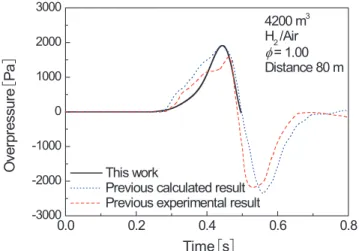1. Introduction
A gas explosion is a potentially serious hazard in chemical process industries such as storage facilities for hydrogen, which is becoming a new source of clean energy for the next generation. Gas explosions occur occasionally and, when they do, they tend to be very destructive. The blast wave generated from such an explosion can cause serious damage over a considerable area. Thus, the ability to estimate blast wave pressure is a prerequisite for providing a higher degree of safety.
A model for the estimation of the blast wave pressure resulting from a gas explosion has been proposed by Thomas and Williams
1).This model assumes that an increase in overpressure is generated by the volume variation of gas expansion and that the propagation of the flame front behaves like an equivalent piston. This model has been adopted for use in many studies, and the validity of the model has been confirmed
2)-7)in cases where the flame propagation velocity is much lower than the sound velocity. A recent study
7)also shows that this model can estimate peak overpressure quantitatively, regardless of the kind, amount, and equivalence ratio of gas mixtures, under a condition where a blast wave is not converted into a shock wave.
Although many studies have used this model, most of them focused on peak overpressure, which is one of the
parameters for blast wave pressure. However, information on not only peak overpressure but also on specific impulse̶that is the time-integral of overpressure during the positive pressure phase̶is important in providing a higher degree of safety in chemical process industries.
Therefore, in this study, the validity of the model in predicting specific impulse was investigated.
2. Blast model
When a flame propagates at a variable flame velocity ($&
%" $' ) through an infinite uniform medium, the generated pressure (# # ) at any distance (" ) from the center of the explosion is given by the following expression
1),
# #! " ! ' " # %
#!$ ! $
!$"
" % &
%! & " $&
%! & "
$ &
! "
%" &
%%! & " $
%&
%! & "
$ &
%! "
# $,
& #' ! "" !
#(1)
where, ' , $ , &
%, and !
#are time, expansion ratio (unburnt gas density/burnt gas density), the flame position from the explosion center, and sound velocity of the atmosphere, respectively. In this calculation, $&
%" $' and $ for different gas mixtures were obtained from Figure 1 and Table 1 published in a previous study
7). As shown in this previous study
1), %
#is the density of the medium through which the sound is propagating. It should be noted that the initial density of ambient air outside of the
Estimation of impulse of blast wave by flame propagation velocities for premixed gases
Dongjoon Kim
*†*
Research Institute of Science for Safety and Sustainability, National Institute of Advanced Industrial Science and Technology, 111 Higashi, Tsukuba, Ibaraki 3058565, Japan
Phone : +81298614788
†
